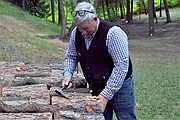Local man warns of beetle and mistletoe infestation
BONNERS FERRY — After seeing signs of beetle infestation in his timber, a local man reached out to local resources for help.
Gerald Higgs of Bonners Ferry discovered an infestation of Western Pine bark beetles on his North Hill property and was concerned that it may be an infestation across the area.
“In late February I started noticing minute insects invading my house that were so small they could crawl through a screen. As time passed and the beetles matured, I recognized the species,” he said.
Higgs told the Herald he quickly picked up all of them in a down brush in order to prevent the beetles from spreading.
He immediately notified the Boundary County University of Idaho Extension Office, the local Idaho Department of Lands and the U.S. Forest Service.
Higgs tried to mail beetles to the University of Idaho by way of the extension office, but the samples were not able to be sent due to logistical problems.
Local IDL officials put Higgs in contact with Jim Kibler, a private forestry specialist in IDL’s Ponderay Lake Area for IDL in the Sandpoint office. Kibler came out and looked over Higgs’ timber at the end of July.
After the beetle attacks, Higgs then noticed that his standing timber was losing color in its pine needles. After collecting samples of fallen tree limbs, he noticed that light green moss was spreading across the bark. This was later identified as a variety of dwarf mistletoe.
The mistletoe attacks Ponderosa Pine, which is most of Higgs’ timber. Once a tree gets stressed, which makes it a magnet for other attacks, officials said.
Higgs said he can’t reforest the property due to the high deer population constantly eating saplings and wanted to keep as much of his timber as possible.
Higgs was concerned with many of his pines turning brown, thinking it was part of disease spreading from tree to tree, noting that some of his neighbors also had pines turning brown.
Kibler said that in some instances this could be the tree self-pruning as ponderosa pine only holds three years of needles. Beetles, however, can harbor and spread fungus when burrowing into trees.
Higgs cut down trees he suspected were diseased and Kibler examined the cut timber, by peeling back the bark looking for holes showing beetles had entered.
The beetles communicate by releasing pheromones announcing when a tree is filled with beetles and when to move on to another tree. Kibler suggested getting pheromone patches which would warn off the beetles.
From there, Kibler took photos of the samples and sent them to a visiting entomologist for more information and to find a course of action for the landowner.
Kibler said, the trees might not die from the interaction with the beatles and mistletoe, but its damage could affect the price of the timber if it were harvested. He added it is a best practice to keep forest floor clear to prevent spreading of disease, noting that Higgs had already done that.
He added that the dwarf mistletoe doesn’t kill the tree, rather it is a parasite and has a symbiotic relationship with the tree.
Since nature has no respect for property lines, to Higgs it looks like dwarf mistletoe looks to still be spreading to neighboring properties, he said when pointing out similar features that hint at infestation.
Overall Higgs said the process to get help to inspect his timber was discouraging, since he had to go through so many different organizations and mediation methods are limited.
For his plan of action, Higgs is looking to fell trees that have a threat of falling on his house and have been damaged by the infestation. Trees that are not at risk to property, he will let fall on their own time.
“I found beetles in my house again [Aug. 3],” Higgs told the Herald. “The little ones I collected as samples in the spring have now turned to adults.”
Telltale signs of infestation in timber may include:
• Excessive woodpecker holes in the tree bark
• Bark exfoliation
• Presence of sawdust at the trunk base
• Pitch drool on bark exterior
• Tunneling of the cambium layer beneath the bark
• A developing gray-green color of needles; progressive thinning of crown
• Top and branch die off
Unfortunately, by the time symptoms are readily noticeable, it is too late to save the tree(s). Diseased trees should be removed to prevent spread of infestation. All tops should be burned or removed immediately. Any wood kept on premises should be thoroughly sprayed with insecticide as fresh sap will only attract more beetles.
Surface applied systemic herbicides may be used to the ground out to the root perimeter, but this will require the removal of all ground cover. This method of treatment may only be successful on younger less established trees.
Prevention should include:
• Having an expert cruise your timber
• Maintain timber diversity of multiple species
• Thin out excess tree density
• Control brush undergrowth
• Remove older, unhealthy timber
• Do not introduce firewood gathered elsewhere near your timber.
Any suspected infestations should be reported to the agencies above.
Information gathered from discussions with the Idaho Department of Lands, Bonners Ferry Ranger District, Kennon McClintock with Nature Conservancy of Moyie Springs and Dennis McLeish, a local arborist.



